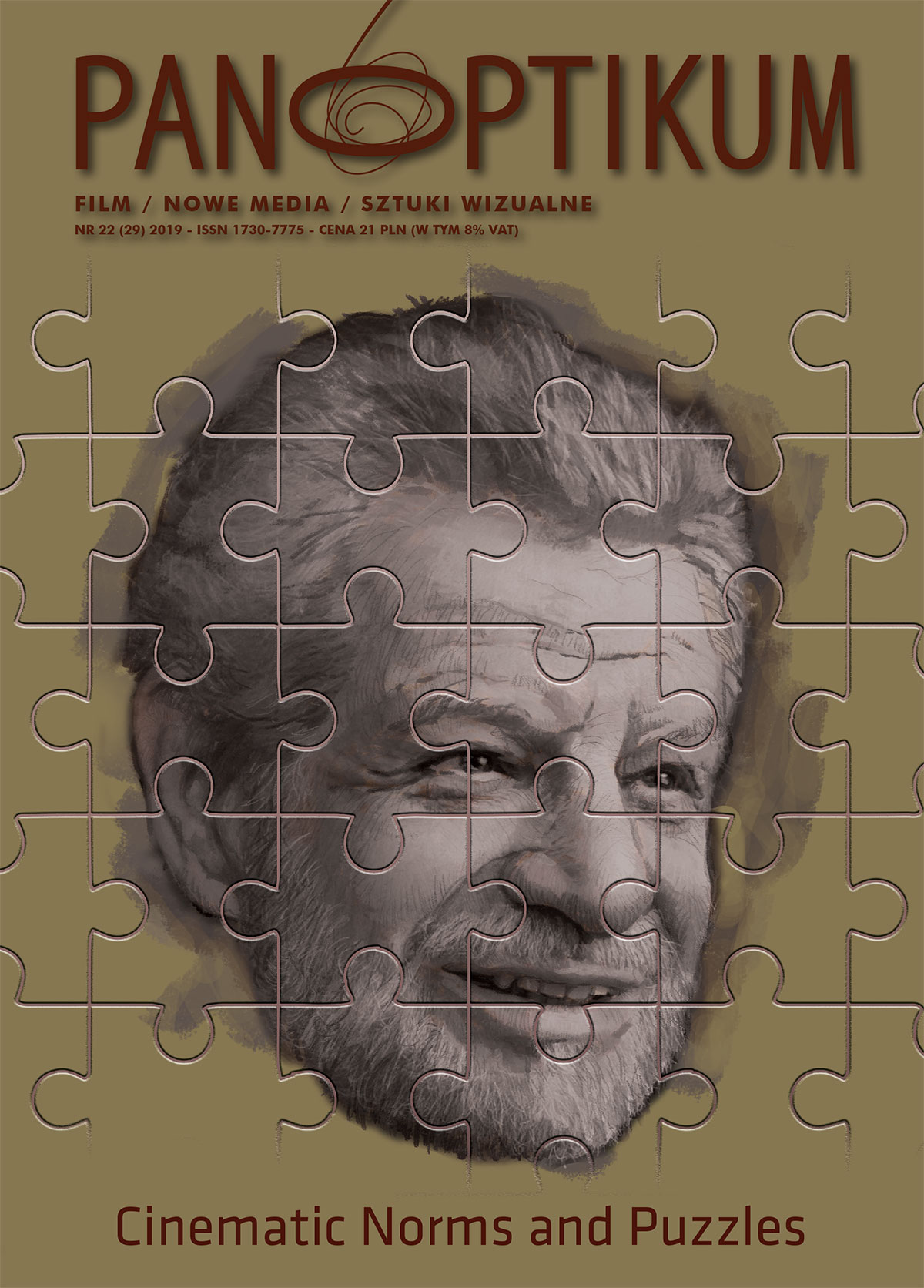From Point of View to Mindgame Films – Between Subjective Techniques and Strategies
DOI:
https://doi.org/10.26881/pan.2019.22.03Abstrakt
The starting point for this paper is the statement that subjectivisation (subjective narrative) – is one of the key elements in a film medium. However, when its definition is narrowed down, it neither reflects the character of changes in the scope of the opposition between objective-subjective nor its resonance with the notions of individuality, personality or the community.
I focus on a historical expansion of subjectivisation techniques, but there is much more. I would like to answer the question about the way in which these techniques fit into the differences between paradigms and modes of cinema. Firstly, I consider subjectivisation techniques in Pre-Classical Cinema, PreModernist Cinema and Classical Cinema. Secondly, I reveal how subjectivisation techniques develop into strategies and how certain figures are given less or more importance within narratives. In this context I research subjectivisation in Modernist Cinema. Thirdly, I draw attention to the relationship between subjectivisation techniques and strategies in contemporary Post-Classical Cinema (the cinema of attractions, interactive techniques). My final suggestion is that mind-game films (representing Postmodernist Cinema) are the domain of a subjectivisation strategy. I have no doubt that the conflict between faith in the objective and faith in the subjective present in cinema leads to the ultimate victory of subjectivity, while what is objective becomes inaccessible.
Mind-game films offer us an exercise in “productive pathologies”, they teach us non-linear thinking, by means of leaps, associations, and all while being distracted. They teach us to switch between schizophrenic regions where nothing is the way it appears to be.
Downloads
Bibliografia
Altman, R. (2008). A Theory of Narrative. New York: Columbia University Press.
Bordwell, D. (1985). Narration in the Fiction Film. Madison: University of Wisconsin Press.
Bordwell, D. (2006). The Way Hollywood Tells It: Story and Style in Modern Movies. Berkeley: University of California Press.
Branigan, E. (1992). Narrative Comprehension and Film. Abingdon: Routledge.
Branigan, E. (1984). Point of View in Cinema. A Theory of Narration and Subjectivity in Classical Film. Berlin-New York-Amsterdam: Mouton Publishers.
Brikholc, R. (2019). Podwójna perspektywa. O subiektywizacji zapośredniczonej w filmie. Kraków: Univeristas.
Buckland, W. (2014). Introduction: Ambiguity, Ontological Pluralism, and Cognitive Dissonance in the Hollywood Puzzle Film, in: Buckland W. (ed.) Hollywood Puzzle Film. New York: Routledge.
Cameron, A. (2008). Modular Narratives in Contemporary Cinema. New York: Palgrave Macmillan.
Chatman, S. (1978). Story and Discourse. Narrative Structures in Fiction and Film. London: Cornell University Press.
Deleuze, G. (1996). Cinema 1. The Movement-Image, (Trans. H. Tomlinson, B. Habberjam), Minneapolis: University of Minnesota Press.
Deleuze, G. (1995). Cinema 2. The Time-Image, (Trans. H. Tomlinson, R. Galeta), Minneapolis: University of Minnesota Press.
Deleuze, G.; Guattari, F. (1983). Anti-Oedipus. Capitalism and Schizophrenia, (Trans. M. Seem H.R. Lane), London: The Althone Press.
Eisner, L. (2011). Ekran demoniczny, przeł. K. Eberhardt, Gdańsk: słowo/obraz terytoria.
Elsaesser, T. (2018). Kino gier umysłowych, Trans. M. Przylipiak, in: Kino – maszyna myślenia. Refleksje nad kinem epoki cyfrowej. Gdańsk: Wydawnictwo Uniwersytetu Gdańskiego.
Fludernik, M. (2005). Towards a ‘Natural’ Narratology. London/New York.
Foucault, M. (1983). Preface, in: Deleuze Gilles, Guattari Félix, Anti-Oedipus. Capitalism and Schizophrenia, (Trans. M. Seem H.R. Lane), London: The Althone Press.
Foucault, M. (1977). Archeologia wiedzy, Trans. A. Siemek, Warszawa: Państwowy Instytut Wydawniczy.
Garbicz, A.; Klinowski, J. (1981). Kino, wehikuł magiczny. Przewodnik osiągnięć filmu fabularnego. Podróż pierwsza 1913-1949. Kraków: Wydawnictwo Literackie.
Gunning, T. (1986). The Cinema of Attraction: Early Film, Its Spectator and the Avant Garde. “Wide Angle”, Vol. 8, No. 3–4.
Helman, A. (1997). ”Zezowate szczęście”. Między biegunami interpretacji. ”Kwartalnik filmowy’, No. 17.
Jahn, M. (2017). Narratology: A Guide to the Theory of Narrative, http://www.uni-koeln. de/~ame02/pppn.pdf (accessed 16.12.2019).
Jakubowska, M. (2006). Żeglowanie po filmie. Kraków: Rabid.
Jakubowska, M., Żyto, K. Labirynt i kłącze – paradygmaty współczesnej narracji filmowej, in: Paradygmaty współczesnego kina, R.W. Kluszczyński, T. Kłys, N. Korczarowska- Różycka (red.). Łódź: Wydawnictwo Uniwersytetu Łódzkiego.
Jakubowska, M. (2013). Kryształy czasu. Kino Wojciecha Jerzego Hasa, Łódź: Wydawnictwo UŁ oraz Wydawnictwo PWSFTviT.
Kawin, B. F. (1978). Mindscreen. Bergman, Godard and First Person Narration. Princeton.
Kłys, T. (1999). Film fikcji i jego dominanty, Warszawa: Semper.
Kłys, T. (2010). Film niemiecki w epoce wilhelmińskiej i weimarskiej, in: Kino nieme, (ed.) T. Lubelski, I. Sowińska, R. Syska (red.). Kraków: Universitas.
Lubelski, T. (1992). Strategie autorskie w polskim filmie fabularnym. Lata 1945-61. Kraków: Rabid.
Mitry, J. (1998). The Aesthetics and Psychology of the Cinema, Trans. Ch. v King. London: Althone Press.
Ostaszewski, J. (2018). Historia narracji filmowej. Kraków: Universitas.
Ostaszewski, J. (2010). Narrator niewiarygodny w filmie fabularnym. ”Kwartalnik Filmowy”, No. 71–72.
Ostaszewski, J. (2017). Techniki subiektywizacji w filmie fabularnym. “Kwartalnik Filmowy”, No. 97–98.
Pisters, P. (2012). The Neuro-Image: A Deleuzian Filmphilosophy of Digital Screen Culture. Stanford: Stanford University Press.
Przylipiak, M. (1987). O subiektywizacji narracji filmowej. ”Studia Filmoznawcze”, t. VII, (ed.) J. Trzynadlowski, Wrocław.
Przylipiak, M. (2016). Kino stylu zerowego. Dwadzieścia lat później. Sopot: Gdańskie Wydawnictwo Psychologiczne.
Syska, R. (2014). Filmowy neomodernizm. Kraków: Wydawnictwo Avalon.
Szczekała, B. (2018). Mind-game films. Gry z narracją i widzem. Łódź: Narodowe Centrum Kultury Filmowej.
Zalewski, A. (1998). Strategiczna dezorientacja. Perypetie rozumu w fabularnym filmie postmodernistycznym. Warszawa: Instytut Kultury.
Żyto, K. (2010). Strategie labiryntowe w filmie fikcji. Łódź: Wydawnictwo Uniwersytetu Łódzkiego.

 Uniwersyteckie Czasopisma Naukowe
Uniwersyteckie Czasopisma Naukowe









